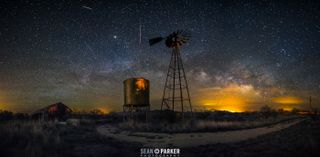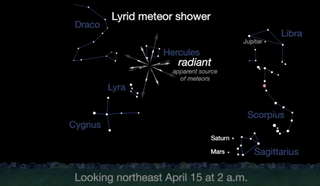Dazzling Lyrid Meteor Shower Peaks This Weekend!

Keep an eye out for shooting stars early Sunday morning (April 22): The Lyrid meteor shower has been active, and will hit its peak after midnight.
Observers under dark skies in the Northern Hemisphere can view as many as a dozen Lyrid meteors each hour in the early morning from mid- to late April. And up to 20 meteors per hour will likely be visible overnight Saturday to Sunday (April 21-22), according to NASA's Jet Propulsion Laboratory (JPL) and the Space Science Telescope Institute (STScI).

The Lyrids are classified as a medium-strength shower, according to STScI, and are visible every year in April. The shower appears to emanate from the constellation Lyra (the Harp), hence its name. People have been watching these streaks for thousands of years: Chinese astronomers recorded the shower back in 687 B.C., according to NASA. The Lyrids result each year when Earth passes through the trail of dust and debris left behind by Comet Thatcher; the icy rock itself is expected to return to the solar system in 2276, after its most recent approach in 1861. [The Most Amazing Lyrid Meteor Shower Photos of All Time]
Observers in the U.S. will also have a good view of these shooting stars on the nights before and after the Lyrids peak (after midnight on Friday, and after midnight on Sunday), according to JPL. The moon is bright because it's at a first-quarter phase, so NASA suggests waiting until the moon sets at midnight to see the Lyrids.
If you are making plans to skywatch this weekend, keep in mind that there are also many other shining objects to search for. Before midnight, a few hours before prime Lyrid shower viewing, Jupiter rises in the east, according to NASA. The giant gas planet and its Great Red Spot are visible with a regular telescope. Mars and Saturn join the night sky in the hours before dawn, in the summer constellation Sagittarius, STScI said in a recent video. The constellation Leo (the Lion) is also worth keeping an eye out for. It appears in the south, and worth spotting are the Leo Triplet galaxies near the belly of the beast, as well as the heart of the lion, the star Regulus.
Follow Doris Elin Salazar on Twitter @salazar_elin. Follow us @Spacedotcom, Facebook and Google+. Original article on Space.com.
Get the Space.com Newsletter
Breaking space news, the latest updates on rocket launches, skywatching events and more!
Join our Space Forums to keep talking space on the latest missions, night sky and more! And if you have a news tip, correction or comment, let us know at: community@space.com.

Doris is a science journalist and Space.com contributor. She received a B.A. in Sociology and Communications at Fordham University in New York City. Her first work was published in collaboration with London Mining Network, where her love of science writing was born. Her passion for astronomy started as a kid when she helped her sister build a model solar system in the Bronx. She got her first shot at astronomy writing as a Space.com editorial intern and continues to write about all things cosmic for the website. Doris has also written about microscopic plant life for Scientific American’s website and about whale calls for their print magazine. She has also written about ancient humans for Inverse, with stories ranging from how to recreate Pompeii’s cuisine to how to map the Polynesian expansion through genomics. She currently shares her home with two rabbits. Follow her on twitter at @salazar_elin.
